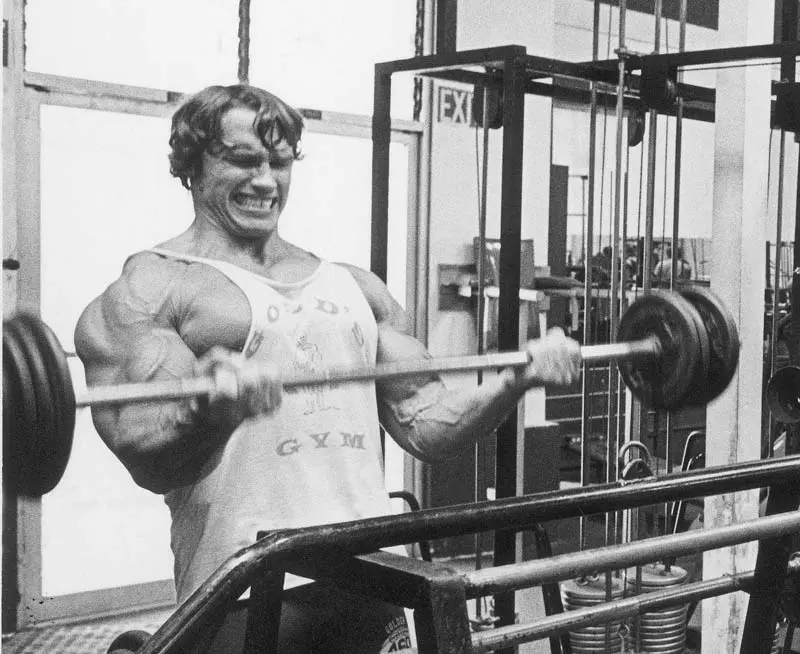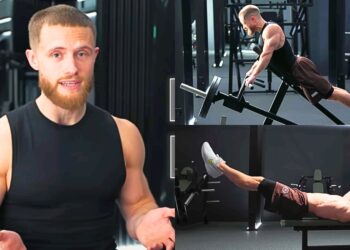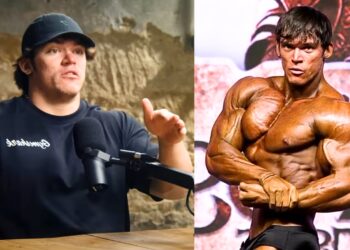Don’t worry if you have never heard the term “eccentric” before. You are not alone. You might be unaware of eccentric exercises, but you perform them every time you are in the gym.
Confused? Let me explain.
There are three main types of muscle contractions:
- Eccentric: Refers to when the muscle lengthens. For example, when you are lowering down into a squat.
- Concentric: It is when the muscle contracts, like the lifting phase during a dumbbell bicep curl.
- Isometric: This refers to the static contraction of a muscle without any visible movement in the angle of the joint, such as in a plank.
Although most training regimens incorporate all three movements, eccentric is often the most overlooked and underutilized. Most lifters will spend hours curling dumbbells and focusing on contracting their guns at the top of the movements to build a solid bicep peak, but they fail to make the most of the eccentric part of the lift. Their plan for the eccentric movement of a lift is usually to let gravity do its thing.
As a personal trainer with over seven years of hands-on experience, I’ve helped numerous clients transform their physiques by turning their focus to milking the eccentrics. In this article, I teach you everything you need to know about eccentric-focused training and the six best exercises that should be a part of your arsenal.
Level Up Your Fitness: Join our 💪 strong community in Fitness Volt Newsletter. Get daily inspiration, expert-backed workouts, nutrition tips, the latest in strength sports, and the support you need to reach your goals. Subscribe for free! Recent Updates: On June 19, 2024, Fitness Volt’s Senior Editor, Vidur Saini (American Council on Exercise-CPT), updated the article and added actionable expert tips throughout the piece to improve the reader experience.
Check out: Eccentric Vs. Concentric Training
6 Best Eccentric Exercises
The great thing about incorporating eccentric exercises in your training is you’re probably already doing most of these, but just faster. You could turn any exercise into an eccentric-focused move by modifying the rep tempo or using the ‘negatives’ advanced training technique.
Here are a few of the eccentric exercises and how to perform them:
- Eccentric Pull-Up (3-5 Eccentric Rep Tempo)
- Eccentric Calf-Raise (Bilateral Concentric – Unilateral Eccentric)
- Eccentric Barbell Bicep Curl (Forced Reps)
- Eccentric Bent-Over Barbell Row (Super Slow Eccentric)
- Eccentric Barbell Shoulder Press (Eccentric Isometrics)
- Eccentric Cable Tricep Extension (3-5 Eccentric Rep Tempo)
1. Eccentric Pull-Up (3-5 Eccentric Rep Tempo)
| Sets & Reps | 3 sets of 4-6 reps (focus on 3-5 second eccentric) |
| Equipment Needed | Pull-up bar |
| Target Muscles | Latissimus dorsi, biceps brachii, trapezius, rhomboids, posterior deltoids |
Most people fail to milk the eccentrics during pull-ups, leaving significant gains on the table. They use all their might to reach the top position and then just drop down to the bottom. Controlling the eccentrics in this exercise can unlock significant size and strength.
- Using a pronated grip, grasp the pull bar with a slightly wider than shoulder-width grip.
- You could either jump to skip the concentric part of the movement or start by standing on a high platform.
- Once your chin is next to the bar, pause for a second, find stability and balance, and slowly lower your body towards the floor. The eccentric part of the movement should last between 3-15 seconds.
- Repeat for reps.
Pro Tip: At the bottom of each rep, engage your scapular muscles by actively depressing your shoulders (think about pushing your armpits down towards your hips). This will increase lat activation and promote a stronger mind-muscle connection.
| Difficulty | Advanced |
| Progression | Weighted pull-ups, one-arm eccentric negatives |
| Regression | Assisted pull-ups, lat pulldowns (slow eccentric) |
2. Eccentric Calf-Raise (Bilateral Concentric – Unilateral Eccentric)
| Sets & Reps | 3 sets of 8-12 reps per leg |
| Equipment Needed | Calf raise machine or step with weight (optional) |
| Target Muscles | Gastrocnemius, soleus |
Research has shown that the eccentric phase might be more anabolic than the concentric, meaning we want to prioritize the lowering movement to build muscle tissue. So, when performing single-leg calf raises, feel free to use both legs during the concentric phase and only one during the eccentrics. (4)
- Set up an elevated platform under a Smith machine.
- Stand up on the block with the balls of your feet on the edge of the platform.
- Raise your heels as high as you can.
- Lift your right foot off the platform and slowly lower your left heel back down as far as possible.
- Once you reach the bottom of the movement, place your right foot back on the platform and repeat.
- Complete five reps on your left foot before switching sides.
Pro Tip: During the unilateral eccentric phase, slightly dorsiflex your ankle (point your toes up) before beginning the lowering phase. This subtle change in position will increase tension on the soleus muscle, leading to greater overall calf development.
| Difficulty | Intermediate |
| Progression | Increased weight, single-leg calf raises |
| Regression | Seated calf raise, bodyweight calf raise (both legs) |
3. Eccentric Barbell Bicep Curl (Forced Reps)
| Sets & Reps | 3 sets of 6-8 reps (with 2-3 forced reps at the end) |
| Equipment Needed | Barbell, spotter |
| Target Muscles | Biceps brachii |
I highly recommend beginners use a spotter to complete the lifting phase during this exercise, as it limits the risk of injury and allows you to focus on the eccentrics.
- Grab a barbell with a shoulder-wide supinated grip (palms facing up).
- Explosively curl the bar to the top of the movement.
- Return to the starting position with a 3-5 second controlled rep tempo.
- After completing 10-12 reps with the same technique, you should have achieved muscle failure.
- Use a spotter’s assistance to lift the bar to the top and slowly lower the bar back to the starting position.
- Repeat for recommended reps.
Pro Tip: Keep your torso upright and shoulder blades pulled back and down during the lowering phase for maximal biceps brachii stimulation.
| Difficulty | Intermediate/Advanced |
| Progression | Increased weight, eccentric preacher curls |
| Regression | Dumbbell bicep curls, resistance band curls |
Related: Static Bicep Curl Exercise Guide — How-To, Benefits, and Variations
4. Eccentric Bent-Over Barbell Row (Super Slow Eccentric)
| Sets & Reps | 3 sets of 6-8 reps (focus on 5-7 second eccentric) |
| Equipment Needed | Barbell |
| Target Muscles | Latissimus dorsi, trapezius, rhomboids, erector spinae |
Eccentrics-focused training increases the time under tension (TUT), forcing your muscles to work harder. Consider using lighter weights than usual if you’ve never tried slow, controlled eccentrics.
- Stand with a shoulder-width stance while holding a barbell using a double overhand grip.
- Hinge forward until your torso is roughly parallel with the floor (or slightly above).
- Explosively pull the bar towards your belly button while keeping your elbows tucked to your sides.
- Take 10-30 seconds to lower the bar back to the starting position.
- Repeat for recommended reps.
Pro Tip: At the top of each rep, actively squeeze your shoulder blades together and hold this contraction briefly before starting the eccentric phase.
| Difficulty | Intermediate |
| Progression | Increased weight, Pendlay rows |
| Regression | Dumbbell rows, inverted rows |
5. Eccentric Barbell Shoulder Press (Eccentric Isometrics)
| Sets & Reps | 3 sets of 4-6 reps (hold eccentric isometric for 5 seconds) |
| Equipment Needed | Barbell, squat rack |
| Target Muscles | Anterior deltoids, triceps brachii |
During the isometric hold at the bottom of the rep, push your head between your arms as if trying to make a double chin. This subtle movement activates the serratus anterior muscle, which helps stabilize the shoulder joint and improves overall shoulder health and performance.
- Sit down on the bench and unrack the bar using an overhand grip.
- Explosively press the bar overhead to a lockout.
- Slowly begin returning to the starting position.
- Hold the weight in position for 2-10 seconds as you are halfway through the range of motion.
- Return to the starting position and repeat for reps.
Pro Tip: During the eccentric phase, visualize pushing your elbows forward rather than simply lowering the bar. This cue shifts the emphasis to the anterior deltoids (front shoulder muscles), maximizing their involvement and growth potential.
| Difficulty | Intermediate/Advanced |
| Progression | Standing dumbbell shoulder press |
| Regression | Seated dumbbell shoulder press, pike push-ups |
6. Eccentric Cable Tricep Extension (3-5 Eccentric Rep Tempo)
| Sets & Reps | 3 sets of 8-12 reps (focus on 3-5 second eccentric) |
| Equipment Needed | Cable machine with rope attachment |
| Target Muscles | Triceps brachii |
This is hands-down my favorite tricep exercise, and the pumps are insane. Be as explosive on the lowering phase and just as slow and controlled on the eccentrics. Keep your chest close to the cable, but avoid using your weight during the concentric phase.
- Attach a straight bar to a cable stack as high as possible and assume a standing position with a shoulder-width stance.
- Grab the bar with a pronated grip (palms facing down) and lean forward slightly by hinging at the hips.
- Push down the bar explosively by extending the elbows and flexing your triceps.
- Taking three to five seconds, return to the starting position in a slow and controlled motion.
- Repeat for reps.
Pro Tip: As you lower the weight during the eccentric phase, gradually flare your elbows outwards. This slight change in elbow position increases tension on the long head of the triceps muscle.
| Difficulty | Beginner/Intermediate |
| Progression | Overhead tricep extensions |
| Regression | Close-grip bench press, tricep dips |
5 Eccentric Training Methods
Here are some ways of incorporating the eccentric exercises into your workouts:
1. The 3-5 Seconds Eccentric Rep Tempo
This is one of the most common and basic yielding-focused training techniques. However, if you don’t already use negative training in your workouts, slowing down the eccentric part of a lift will set your muscles on fire. All the methods in the article result in a longer time-under-tension (TUT) which can help ignite muscle growth.
Level Up Your Fitness: Join our 💪 strong community in Fitness Volt Newsletter. Get daily inspiration, expert-backed workouts, nutrition tips, the latest in strength sports, and the support you need to reach your goals. Subscribe for free!
Must Read: Time Under Tension – Does it Matter or Just a Myth?
2. Eccentric Isometrics
While performing the eccentric isometrics, perform the concentric part of the lift as usual but pause midway for two to ten seconds during the muscle lengthening part of the movement.
With some trial and error, you will find the sweet spot where you get the best muscle contraction in the range of motion. Pause at that spot to maximize muscle activation and recruitment. The techniques mentioned in this list can be used for each rep in a set or just the last rep.
3. Super Slow Eccentric
Now, you might be wondering, “Aren’t eccentric exercises all about the slow lengthening of the muscle, so what’s new with the super slow eccentric technique?”
Well, super slow eccentric is just what the name says — super slow. We are talking 10 to 30 seconds slow. Imagine taking 10 to 30 seconds to lower down into a squat. I don’t know about you, but I could feel a pump in my legs writing the last line.
Pro Tip: You do not have to perform the concentric part of the lift while doing the super slow eccentrics. You could use a spotter to help you with the lifting phase.
4. Bilateral Concentric — Unilateral Eccentric
This method is one of the most brutal eccentric training techniques and is great for fixing muscle and strength imbalances. You will be using a machine or pulley for these types of eccentric exercises.
Use both limbs to explosively complete the concentric part of the lift. Pause at the top to shift the weight to one limb and perform a 3-5 second eccentric phase.
While performing a set of 10 reps, perform five reps on one limb before switching to the opposite limb.
5. Forced Reps
Forced reps are one of the most unforgiving eccentric training techniques. Choose a weight that will get you to muscle failure between 10-12 reps. After you reach failure, perform 3-5 reps with light assistance from a spotter through the concentric range of motion. You need to lower the weight without any help from your training partner.
Remember, light assistance from a partner means just enough help to push through the sticking point. Do not ask the spotter to lift the weight for you.
Choose one of the methods listed above and stick with it for at least five to six weeks to get the best bang for your buck.
Pro Tip: To make the most of eccentric training, you would need a training partner. The spotter would help you through the concentric part of the lift and stabilize you as you lower the weight — if necessary. They could also monitor your rep tempo and form.
Benefits of Eccentric Training
Here are a few advantages of streamlining eccentric training in your training routine:
1. Helps Generate Energy For The Concentric Part of a Lift
Also referred to as the negatives or negative training, controlling the eccentric part of an exercise helps absorb the mechanical energy exerted by the heavy load on your muscles. The energy is then released with an elastic recoil, essentially a spring-like action that facilitates the concentric movement.
According to a study, lengthening the muscle fibers during eccentric training can also improve flexibility and range of motion, and lessen the risk of injury during training. [1]
2. Helps Build Muscle Size and Strength Better Than Conventional Movements
According to research, eccentric training can build muscles size and strength better than standard concentric-eccentric movements. Since you only have to focus on the eccentric part of an exercise, you can lift heavier and find a better mind-muscle connection than the conventional lift. Over time, the strength from the eccentric lifts will carry over to the concentric part of a lift. [2]
Must Read: Strengthen Your Mind-Muscle Connection for Better Bodybuilding Results
3. May Be Beneficial in Weight Loss
An eccentric contraction uses less energy and oxygen than a concentric contraction. However, the negative (or yielding) movement creates more force, enhancing muscle growth and increasing metabolism rate in the process.
As per a Wayne State University study, a full-body eccentric workout increased the resting metabolism in athletes by nine percent. Additionally, the subjects showed an elevated metabolic rate for at least three hours following exercise. [3]
4. Muscle Rehabilitation
Eccentric exercises are common in physical rehab and therapy. Eccentric contractions create more force with less energy, making it less likely to overtax injured joints and muscles.
ACL injuries are typically treated with eccentric exercises as the downward movement is less likely to compromise the stabilizing ligaments of the knee. On the other hand, concentric movements require you to lift and stabilize the weight and your body simultaneously, placing extreme stress on your joints.
A few other injuries for which eccentric training can be helpful include:
- Patellar tendonitis, aka “Jumper’s knee”
- Tendinosis
- Muscle-tendon injuries
- Sarcopenia
- Osteopenia — diminishing bone mineral density
5. Great For Beginners
While ‘negatives’ are considered an advanced training technique and are usually performed by the biggest guys in a gym, it doesn’t have to be that way. Eccentric exercises require you to follow a slow and controlled motion throughout the lift, which can be a great way of learning the correct form of performing a movement. It can also help in establishing a mind-muscle connection, inducing muscle-ripping pumps.
Additionally, eccentric training needs less oxygen, a lower cardiac output, and is known to produce less lactate build-up within the muscle than concentric training when using similar loads, all of which are easier on your body.
Related: Five Powerlifting Training Methods That Bodybuilders Should Use
Disadvantages and Risks of Eccentric Exercises
Eccentric exercises can increase the risk of delayed onset muscle soreness (DOMS) as the micro-tears that develop as a contracted muscle lengthens, causing soreness and pain 24 to 72 hours after a workout.
Additionally, lifting more weight than you can handle in eccentric-focused exercises significantly increases the odds of an injury. As a rule of thumb, while performing the eccentric exercises, you should use the weight you use while performing the conventional eccentric-concentric lifts. Many people put themselves at risk of injury by thinking they can handle heavier weight since they only have to focus on one part of the lift.
Check out: 5 Ways To Speed Up Muscle Recovery
Different Ways of Incorporating Eccentric Exercises in Your Workouts
Eccentric/yielding/negative training methods increase the stress placed on your muscles and nervous system during the ‘lengthening’ part of the lift. Eccentric movements can be used in your training in the following ways:
- Slowing down the eccentric tempo of some or all of your reps.
- Inserting isometric pauses in the eccentric part of the lift in some or all of your reps.
- Forgoing concentric and sticking with the eccentric part of an exercise — negatives.
- After reaching failure on the conventional eccentric-concentric lift, performing additional negatives-only to failure.
- Using heavier weight while performing the eccentric-only reps.
Wrapping Up
Besides the exercises mentioned above, you could make any exercise more eccentric-focused by slowing down your rep tempo in the lengthening part of the lift.
Furthermore, if you are someone who routinely finds themselves going mindlessly through the motions just for the sake of it, incorporating eccentric exercises into your training routine will help you take your gains to the next level. The fact that you don’t need additional equipment to reap the benefits of the advanced training technique makes it worth a shot.
References
- Mackey AL, Kjaer M. Connective tissue regeneration in skeletal muscle after eccentric contraction-induced injury. J Appl Physiol (1985). 2017 Mar 1;122(3):533-540. doi:10.1152/japplphysiol.00577.2016. Epub 2016 Aug 25. PMID: 27562842.
- Julian V, Thivel D, Costes F, et al. Eccentric training improves body composition by inducing mechanical and metabolic adaptations: A promising approach for overweight and obese individuals. Front Physiol. 2018;9:1013. doi:10.3389/fphys.2018.01013
- Hackney, Kyle J; Engels, Hermann-J; Gretebeck, Randall J Resting Energy Expenditure and Delayed-Onset Muscle Soreness After Full-Body Resistance Training With an Eccentric Concentration, Journal of Strength and Conditioning Research: September 2008 – Volume 22 – Issue 5 – p 1602-1609 doi:10.1519/JSC.0b013e31818222c5
- Kinoshita, M., Maeo, S., Kobayashi, Y., Eihara, Y., Ono, M., Sato, M., Sugiyama, T., Kanehisa, H., & Isaka, T. (2023). Triceps surae muscle hypertrophy is greater after standing versus seated calf-raise training. Frontiers in physiology, 14, 1272106. https://doi.org/10.3389/fphys.2023.1272106










